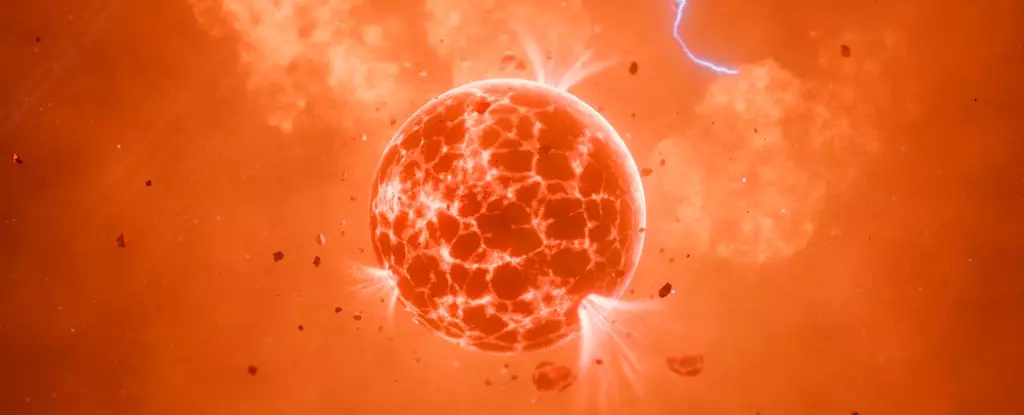Recent discoveries in the cosmos are continually reshaping our understanding of planetary systems beyond our own. A peculiar case has emerged around a distant star, 635 light-years from Earth, where astronomers have uncovered compelling evidence of a highly volcanic moon orbiting an exoplanet designated as WASP-49b. This intriguing discovery, supported by the presence of a significant sodium cloud, serves as a fascinating puzzle for astrophysicists and raises numerous questions about the nature of celestial bodies in distant realms.
The sodium cloud surrounding WASP-49b has sparked intense scientific interest due to its unusual characteristics. Notably, this cloud does not appear to conform to expected behavior for materials within a gas giant’s atmosphere, leading researchers to theorize that it might instead originate from an exomoon that is rich in volcanic activity—akin to what we observe with Jupiter’s moon, Io. The observations imply that this sodium emission is inconsistent with standard planetary dynamics, suggesting an external source of volcanism that challenges existing models on gas giants.
Despite the Solar System’s rich tapestry of moons—nearly 300 known—a rather surprising scarcity of evidence exists for exomoons in our galaxy. With a handful of planets known so far, many planetary systems remain enigmas waiting to be unraveled. The difficulty in detecting exomoons is compounded by the fact that the signals emitted by these celestial bodies are often faint, easily overshadowed by their parent planets or stars. Therefore, the instances when we do identify potential exomoons often require extensive and sophisticated observational techniques that can mitigate noise and distinguish meaningful data.
In the world of exoplanet research, the initial findings frequently lean towards observable extremes, leaving us with the potential of sampling only the most prominent examples of planetary behavior. For WASP-49b, the intriguing sodium cloud may just represent the vanguard of what could be a series of significant discoveries concerning exoplanets and their satellites.
Astrophysicist Apurva Oza and his team have meticulously reviewed multiple data sets to analyze the origins of the sodium cloud in question. Their groundbreaking research, starting back in 2017 and further elucidated in studies published in subsequent years, proposes that the volcanic activity on the hypothetical moon could be responsible for the sodium emissions rather than the planet itself.
Their findings hinge on crucial observations gathered via the European Southern Observatory’s Very Large Telescope. The researchers discovered that the sodium cloud fluctuates in visibility, appearing intermittently as it moves in relation to both the star and the exoplanet. Such behavior aligns with expectations of a volcanic moon orbiting a gas giant, providing a novel lens through which to study the intricate dance of celestial dynamics at play in this system.
Theoretical models and computer simulations contribute further insights into the mechanics of this suspected volcanic moon. Oza’s team suggests that this satellite could be experiencing a significant gravitational pull from WASP-49b, which, combined with its own geological activity, could lead to a fascinating interaction reminiscent of the relationship seen between Jupiter and Io. The constant gravitational tugging may generate volcanic eruptions, distorting the moon’s surface and potentially leading to its eventual demise as its orbit decays.
The implications of a volcanic exomoon in such close proximity to its parent planet are staggering: continued eruptions may erode its structure, pushing it closer to the gas giant until it ultimately succumbs to planetary gravitational forces.
This discovery not only broadens our understanding of the WASP-49 system but also emphasizes the importance of ongoing exoplanetary research. As instruments and methodologies advance, we are likely to encounter more instances that challenge our current definitions and models related to moon formation and behavior in the universe. The study of exoplanets and their accompanying moons might one day reveal life-sustaining properties in places previously considered inhospitable.
The potential for discoveries like that of WASP-49b’s exolunar companion opens a portal to further contemplation about what lies beyond our own Solar System. As researchers excavate the layers of understanding surrounding distant worlds, our knowledge expands, reminding us continuously that the cosmos is a rich expanse filled with surprises waiting to be explored. The quest for knowledge in astronomy, therefore, not only satisfies scientific curiosity but sparks humanity’s imagination about our place in the universe.


Leave a Reply